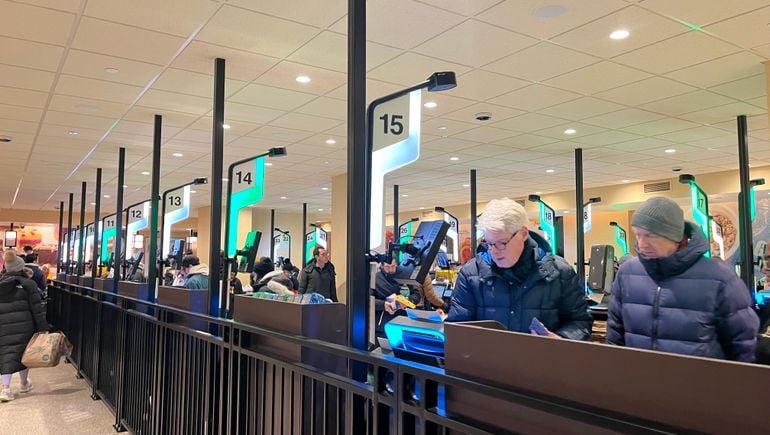If recent news reports are to be believed, self-checkout terminals are a failed experiment, and retailers all over the world are beginning to pull them out of their stores.
Are we witnessing the beginning of the end for a technology that grocers have come to rely on over the past few years?
To paraphrase Mark Twain, the news reports of self-checkout’s death have been greatly exaggerated.
Self-checkout machines aren’t going anywhere. In fact, judging from conversations I’ve had with industry experts in recent weeks, as well as from our reporting and observations at recent trade shows, retailers’ reliance on the technology is actually growing.
Reports have pointed to recent small-scale shifts at Walmart and Target and to U.K. retailer Booths’ recent decision to boot self-checkout machines from its stores. But plenty of other retailers have lately increased their reliance on the devices. Amazon Fresh stores are adding the checkout kiosks into their refreshed locations, while Wegmans’ newly opened Manhattan supermarket has a supersized self-checkout section with about three dozen of the machines — which is pretty impressive, given the short leash Wegmans tends to give checkout tech.
The same trend applies if you look abroad. The Turkish chain Migros has had self-checkout kiosks in its stores for more than 15 years and doesn’t plan on scaling back, Mustafa Bartin, CEO of Migros Retail Turkey, told me in a recent message. Sebastian Rennack, an analyst with Aletos Advisory in Germany, visited retailers in more than 12 European countries in the past year and said he saw an increased investment in self-checkout, not a pullback.

Retailers in the U.S. and abroad are increasing their investment in self-checkout machines.
Permission granted by Sebastian Rennack
The fact that self-checkouts are thriving amid a public backlash speaks to the operational upsides they offer for retailers, namely labor efficiency and cost savings. Despite many consumers’ complaints about their desire to check out with an actual human worker, retailers have struggled to find those humans to work their front ends.
Self-checkout machines also help retailers process more shoppers without having to pay more people to do that work. At a time when retailers are looking to cut costs wherever they can and get the most out of their employees in a low-margin business, that’s an enticing proposition.
Self-service is sweeping across other industries. Walk into just about any McDonald’s these days and you’ll be greeted by a digital kiosk that handles ordering and payment. Convenience stores are also rapidly adding self-checkout kiosks right now because they’re struggling to find people to work inside their stores, Toby Awalt, vice president of marketing with self-checkout technology firm Mashgin, told me.
That all said, self-checkout is an evolving technology that has legitimate flaws. In many stores, the only thing stopping people from swiping items without scanning is a single employee who’s trying to watch over numerous terminals and may not even have a clear view of them. Buying age-restricted items or produce at self-checkout feels as tedious as going through security at the airport. And don’t even get me started on what it’s like when those product scales malfunction.
Self-checkout is an imperfect technology that got rolled out to shoppers quickly in order to paper over retailers’ operational challenges. While many other retail technologies get improved upon through closed-door testing and careful scaling, self-checkout is going through these growing pains in front of hundreds of millions of consumers.
Grocers need to recognize the limitations of self-checkout and do as much as they can to offset them. They also need to stay on top of the latest innovations that can help improve the user experience and cut down on shrink.
To that end, here are a few thoughts on the best practices retailers are implementing — and should implement — as they wrestle with this technology.
Shrink is a problem, but it’s not a deal breaker
One of the biggest hazards of self-checkout for retailers is the potential for people to make off with goods they didn’t pay for — either wittingly or unwittingly. News reports and recent social media posts have noted retailers shifting their self-checkout strategy significantly because of this.
But shrink isn’t a deal breaker for most companies, said Stewart Samuel, director of retail futures with IGD.
“I think retailers have accepted that there’s going to be some shrink, but that it’s going to be outweighed by the cost savings they have,” he told me.
Still, grocers aren’t content with elevated product loss at their stores. Samuel said technology like advanced cameras and artificial intelligence is helping reduce shrink. Bartin, meanwhile, said Migros plans to increase its investment in security measures for its self-checkout areas.
Retailers need to stay on top of self-checkout innovations
Bad user experiences and elevated shrink are the biggest pain points for self-checkout — something retailers and technology companies are all too aware of.
Promising updates are starting to roll out across the industry. Kroger stores use an AI-fueled system from Everseen to detect when a shopper has failed to scan an item. The system gives shoppers a friendly reminder to start, then alerts a store employee if the action isn’t taken.
At a Wegmans’ store in New York, my colleague Catherine Douglas Moran noticed video monitors affixed to the kiosks that show shoppers while they’re checking out — a subtle reminder that people are being watched, whether they like it or not.

A Wegmans self-checkout machine includes live video of the customer checking out.
Catherine Douglas Moran/Grocery Dive
While well-intentioned hints might help prevent theft at self-checkout terminals, it’s important to ensure that messaging aimed at ensuring people handle their items properly doesn’t put them off. A harsh voice commanding a shopper to “place your item in the bagging area!” might prompt them to do as the machine wants, but could also dissuade them from using self-checkout the next time they make a purchase at the same retailer.
Innovation is also making incremental improvements to the chore of scanning and bagging your own groceries. Retailers are probing technology that can recognize produce, keeping shoppers from having to punch in those annoying PLU codes. Self-checkout suppliers are also using AI to estimate peoples’ age when buying age-restricted items — an opt-in task that could prove to be a double-edged sword. Do I want to know how old a checkout machine thinks I am?
Design innovation is another frontier retailers should investigate. Lowes Foods stores has adopted a front-end system that allows shoppers to choose self-checkout or manned checkout after they’ve waited in a single line. Samuel said he’s seen retailers with self-checkout systems that funnel users based on cart size, while other retailers have U-shaped self-checkout areas that allow workers to more easily monitor and assist customers.
Don’t force people to use self-checkout
A few retailers have tested stores that do away with manned registers and only offer self-checkout machines. But the vast majority of retailers offer both options.
So in theory, if you’re one of the people vehemently opposed to self-checkout, you don’t have to do it. Problem solved.
Well, not really. Many retailers view self-checkout as a strategy to manage overflow rather than a way to offer choice. During busy periods when manned registers have long lines, people may feel like they have no other choice but to use the self-checkout machine they dislike. Force a shopper to do this again and again, and you may lose that customer.
The optics of staffing at the front end are also important. It’s one thing if a grocer has most or all of their registers staffed and are still experiencing long lines. It’s quite another if only one or two lanes are open. In that case, self-checkout feels like something retailers are strong-arming people to do.
Staff self-checkout areas accordingly
Technology promises to help curb theft at self-checkout, but the best and most immediate step retailers can take to reduce shrink is by posting store employees in the area.
Most retailers seem to understand this, though they may be missing some of the finer points. I’ve been in numerous stores where self-checkout was overseen by one preoccupied worker who was poorly placed to monitor the section. At other stores, cashiers are expected to pull double duty as both a checkstand operator and self-checkout minder — a position that erodes both experiences.
Grocers need to place engaged employees at strategic points in self-checkout. If they get bored, rotate the position. Samuel said he usually sees a 6-to-1 ratio of checkout terminals to workers. Go any higher than that and you risk having too many shoppers for workers to monitor and respond promptly to issues.

Self-checkout areas should be appropriately staffed to monitor for theft and to ensure customers don’t have to wait too long for assistance.
Courtesy of Lowes Foods
Retailers are taking an express lane approach
It’s a lot of work to process a full cart of products through a self-checkout lane. Most of these kiosks just aren’t built for that task.
The better use is for small basket shopping. To that end, Target recently began testing a policy that limits the number of items that people can swipe at self-checkout stations. News reports have pointed to this as evidence of a pullback in self-checkout, but I actually think it’s a smart move that shows retailers are refining their approach.
Pushy shoppers with more than 10 or 15 items can still edge their way into the area, especially during peak times. But hasn’t that always been the case with grocery express lanes?
Recognize that this technology is imperfect
Although the backlash against self-checkout isn’t putting much of a dent in retailers’ plans for the technology, companies should still be sensitive to peoples’ concerns.
Deploy clear signage that softens self-checkout’s image and helps shoppers through the process. Post well-trained employees in the area and install machines that won’t break down on a dime.
Also recognize that self-checkout will very likely get disrupted at some point in the coming years. Frictionless checkout and smart carts have proven too costly and imperfect so far for retailers to scale — but that may not always be the case. Consumers and technology are evolving at a rapid pace.
It wasn’t so long ago, in fact, that self-checkout was written off by the industry. Invented in the 80s, the technology struggled for years to make a compelling case to retailers to get rolled out at scale. A few key updates and a pandemic later, and now the machines are seemingly everywhere, for better or for worse






